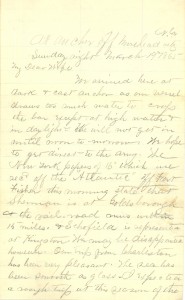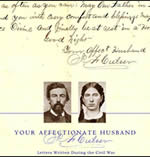 [google-map-v3 width=”400″ height=”300″ zoom=”12″ maptype=”hybrid” mapalign=”right” directionhint=”false” language=”default” poweredby=”false” maptypecontrol=”false” pancontrol=”false” zoomcontrol=”true” scalecontrol=”false” streetviewcontrol=”false” scrollwheelcontrol=”false” addmarkermashupbubble=”false” addmarkerlist=”34.72179; -76.717579{}1-default.png” bubbleautopan=”true” showbike=”false” showtraffic=”false” showpanoramio=”false”]
[google-map-v3 width=”400″ height=”300″ zoom=”12″ maptype=”hybrid” mapalign=”right” directionhint=”false” language=”default” poweredby=”false” maptypecontrol=”false” pancontrol=”false” zoomcontrol=”true” scalecontrol=”false” streetviewcontrol=”false” scrollwheelcontrol=”false” addmarkermashupbubble=”false” addmarkerlist=”34.72179; -76.717579{}1-default.png” bubbleautopan=”true” showbike=”false” showtraffic=”false” showpanoramio=”false”]
At anchor off Morehead City, N.C.
Sunday night, March 19th 1865
My Dear Wife
We arrived here at dark & cast anchor, as our vessel draws too much water to cross the bar except at high water & in daylight. We will not get in until noon to-morrow. We hope to get direct to the Army.1
The New York papers of 16th, which we recd. off the “Atlantic” off Fort Fisher this morning, state that Sherman is at Goldsborough & the rail-road runs within 15 miles, & Schofield is represented at Kingston.2 We may be disappointed, however.
Our trip from Charleston has been very pleasant. The sea has been smooth as glass. I expected a rough trip at this season of the year but was happily disappointed.
We met the “Fulton” on her way to “Hilton Head” with the mail.3 I have not heard from you since I left, except yours of the 8th Febr. recd. in New York. You can imagine my anxiety to receive some intelligence of you. I will hope that you are well & happy. May God bless you.
It is six weeks tonight since I left you. Aside from the sights and changes, it has been about the dullest time I most ever passed. To-day has been but little like Sunday though the day has been very beautiful. We have not been out of sight of land to-day, but the coast from Wilmington up is very barren. We were not sufficiently near Fort Fisher to see its arrangement;4 it looks very formidable at a distance.
The name of this vessel is “New York” & belongs to the Vanderbilt Line.5 There are 1200 troops on board — 52nd Penna, 54th New York, 159th New York, & some detachments.6 Col. Merrill & Capt. Endslee, 70th Ind., and Burk of the Brig. Band compose our party. We left Dr. Bennett at Charleston.
I will write to-morrow if we stop long enough. I have written to-night so that should an opportunity offer we will go forward, and I might not have a chance to write before reaching the command. I am sorry that I have no good news to communicate. Let us hope, however, that God will be pleased very soon to bring this war to a close. Remember me in love to all our friends. I should have written more, but I lacked the energy or disposition, or something else, I don’t know what.
I have had the blues ever since I left home. Write very often. Kiss Howard for me, Pray for me.
Good Bye.
Your affect. Husband.
J. F. Culver
- Sherman’s army had started from Fayetteville for Goldsboro on March 15, the First and Third Divisions of the XX Corps taking the road for Averysboro. The next day near Averysboro. the 129th Illinois, along with other units of Slocum’s wing, engaged a Confederate force led by General Hardee. After a severe fight lasting until dark, the Confederates retreated. The Federals occupied Averysboro on the 17th. Grunert, History of the 129th Illinois, pp. 212-17. [↩]
- The New York papers of the 16th were premature in reporting Sherman at Goldsboro. On the 16th Slocum’s left wing was fighting the battle of Averysboro, and Howard’s right wing was near Owensville. General Schofield, following the defeat of General Hood’s Army of Tennessee at Nashville in mid-December, had been transferred to the Atlantic seaboard with his XXIII Corps. After capturing Wilmington, N.C., Schofield directed his attention to opening a route for supply of Sherman’s army by way of Morehead City and New Bern. By the last day of February, General Cox’s XXIII Corps divisions had been shifted from Wilmington to New Bern. Thrusting inland, the Federals on March 14 occupied Kinston. It was 65 miles from Kinston to Averysboro. Cox, March to the Sea, pp. 147-62. [↩]
- Fulton was a 2,307-ton propeller-driven steamer, built in 1856, and calling New York her home port. Merchant Steam Vessels of the United States, 1807-1868, p. 69. [↩]
- Fort Fisher, one of the Confederate strongholds guarding the approaches to the Cape Fear River and Wilmington, had been captured by a Union amphibious force on January 15, 1864. Until the fall of Fort Fisher, the mouth of the Cape Fear had been a focal point for blockade runners. [↩]
- New York was a new propeller-driven steamer of 2,217 tons. Merchant Steam Vessels of the United States, 1807-1868, p. 138. [↩]
- The 52d Pennsylvania and 100 men of the 54th New York had been embarked at Charleston on March 17, while the 159th New York had boarded the ship at Savannah. These units were under orders to proceed to the mouth of the Cape Fear River, where they would report to the commanding officer, U.S. Forces. O. R., Ser. I, Vol. XLVII, pt. II, p. 897. [↩]

 Subscribe via RSS
Subscribe via RSS Subscribe via Email
Subscribe via Email